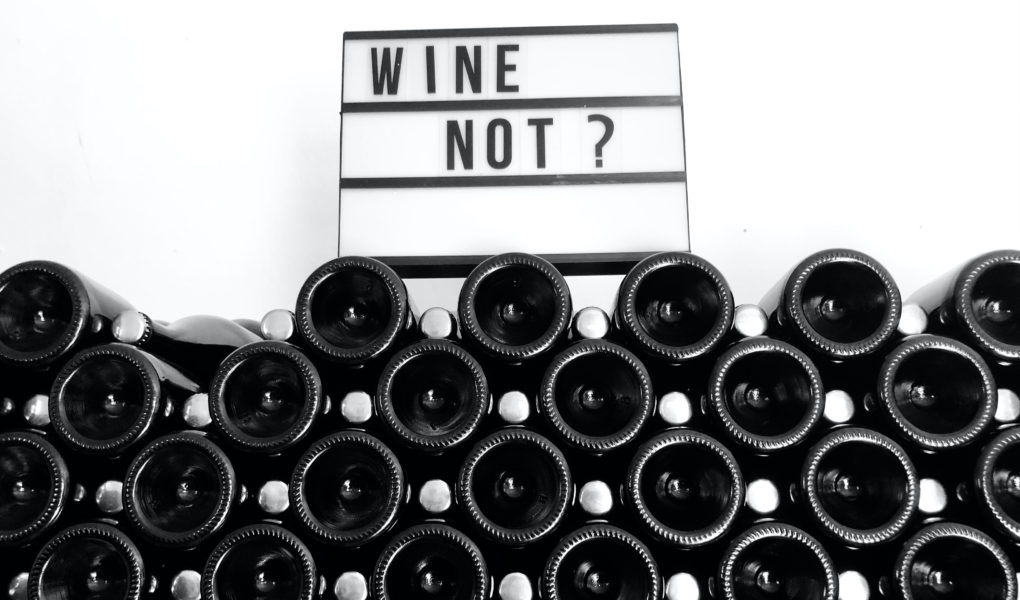Reading wine labels in any country is tricky. The good news is that, once you become used to it, you know what information you should find there and can more easily sort it out. It’s like when you open a book. On the title page, you know you’ll find the title, author and publisher’s name—every time.
In this article we look at four wine labels and unravel the different information on them. Grab your nearest wine bottle (full or empty!) and follow along. Most of the basics are on the red wine label, with additional details on the white, sweet and sparkling labels that follow.
Best Advice for Reading a Croatian Wine Label
The best advice for navigating Croatian wine labels is to get familiar with grape names. In Croatia, the grape variety is shown on the label (as it is in the United States or Australia, for instance) rather than just the region (as in France or Italy).
For most wine lovers, the grape variety is the most important information about a wine—it tells them what the wine will probably taste like. In Croatia, though, many grapes are completely unheard-of in the rest of the world. If you saw Crljenak Kaštelanski on a label, you might not know if it was a grape, a town or the name of the winery. Once you recognize this tongue-twister as Croatia’s Zinfandel grape, you’re halfway to winning the label game.
Focus on Origin, Quality and Style
Almost all wine label information boils down to three subject areas: origin, quality and style. (There’s also some technical stuff like barcodes and lot numbers, which you rarely need to bother with.)
The origin of the wine is important because that wine represents the place where it was made. It was made in Croatia, of course, but you can also telescope down through the region, winery and even vineyard where those grapes were grown. Wine makers in each region are justifiably proud of the wines of their place, so there are rules about how origin is represented on wine labels.
Quality is obviously important to the drinker. Labels attempt to guide you on this, but the best authority on quality is you. If you love the wines from a certain winery, that’s all you need to know.
Certain label information gives you clues to the style of the wine. The most basic example of this is the name of the grape. You may know that Pinot Noir has lighter body than Plavac Mali, for instance. Or the label of a sweet wine may tell you how sweet it is.
Often the best source of style information is the marketing blurb on the back label. If you can read that, it may mention the oak barrels the wine was aged in, or that the grapes were late-harvested—further clues to how the wine will taste.
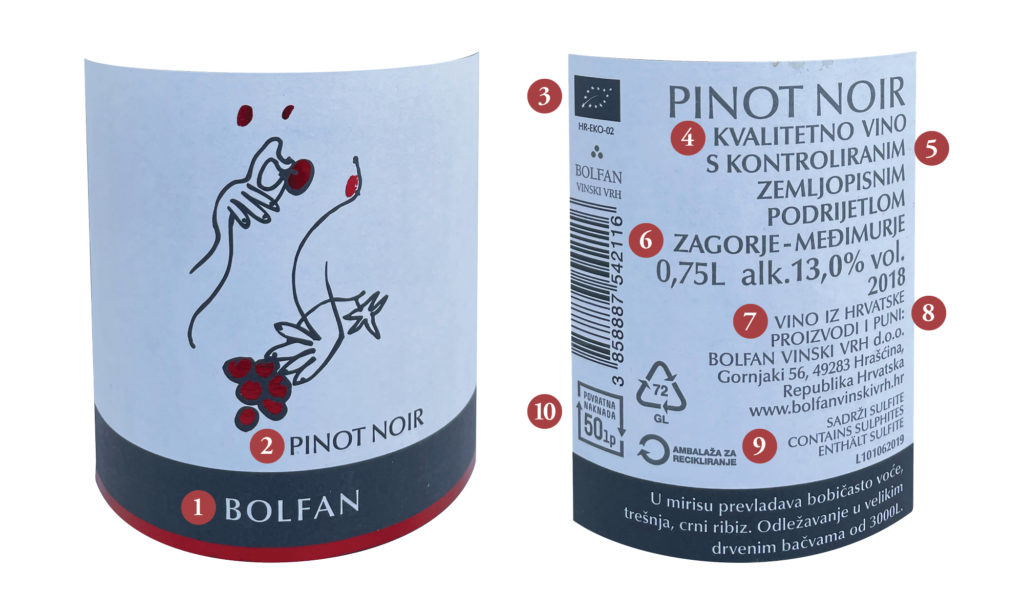
Red Wine Label
1. The name of the winery. This is almost always on the front label, but if you have doubts, see #8.
2. Grape variety. An easy one, thankfully. In Croatia, any single grape variety shown on the front label indicates that wine is made from a minimum 85% of that grape. If it’s a blend, the percentages might be given on the back label. This is up to the winery.
3. Certified organic product label, meaning these grapes were grown organically. This is a quality indicator for most wine lovers.
4. Kvalitetno Vino means quality wine. This is the second official quality level of Croatian wine; the top level is Vrhunsko Vino (premium wine). The level is determined in part by regulations and in part by a tasting panel that determines whether the wine is typical of its kind. Most of the prominent wineries in Croatia submit their wines for this quality rating, but some choose not to.
5. Kontroliranim Zemljopisnim Podrijetlom (KZP) means controlled geographical origin. The EU has a system of designating official regions for the production of wines. Each region has its own guidelines that must be followed in the vineyard and winery in order to use the system. But most countries had their own systems before the EU was formed, or before those countries joined the EU. KZP is Croatia’s own wording from its original system. The EU calls the same thing a Protected Designation of Origin (PDO), which boils down to Zaštićena Oznaka Izvornosti (ZOI) in Croatian. You might see any of these three terms on Croatian wine labels, and they all mean basically the same thing: that this wine is from a specific place registered with the EU especially for wine production.
6. Region. Zagorje-Međimurje is the region where the wine was made. More specifically, it is the registered “geographical origin” referred to in #5.
7. “Vino iz Hrvatske,” which means Wine from Croatia, a required origin statement.
8. “Proizvodi i puni,” which means Produced and filled. This is where you find the legal name of the winery. Sometimes the name of the wine on the front label is a brand name or a fantasy name. But the official name of the winery is always here. “Filled” means the bottles were filled at the winery. There are various situations when wine may not actually be bottled at the winery that made it, but this gets very technical and is isn’t really need-to-know.
9. “Sadrži sulfite,” which means Contains sulfites. A legal requirement in the EU when wine contains at least 10mg/liter of this antioxidant additive, and the vast majority of wines do.
10. “Povratna naknada,” which means Refunds. One of the only technical tidbits you might want to know about, this tells you that you can return the wine bottle for 50 lipa. So, if you return 120 bottles you can use all those lipa to buy one more decent bottle of wine!
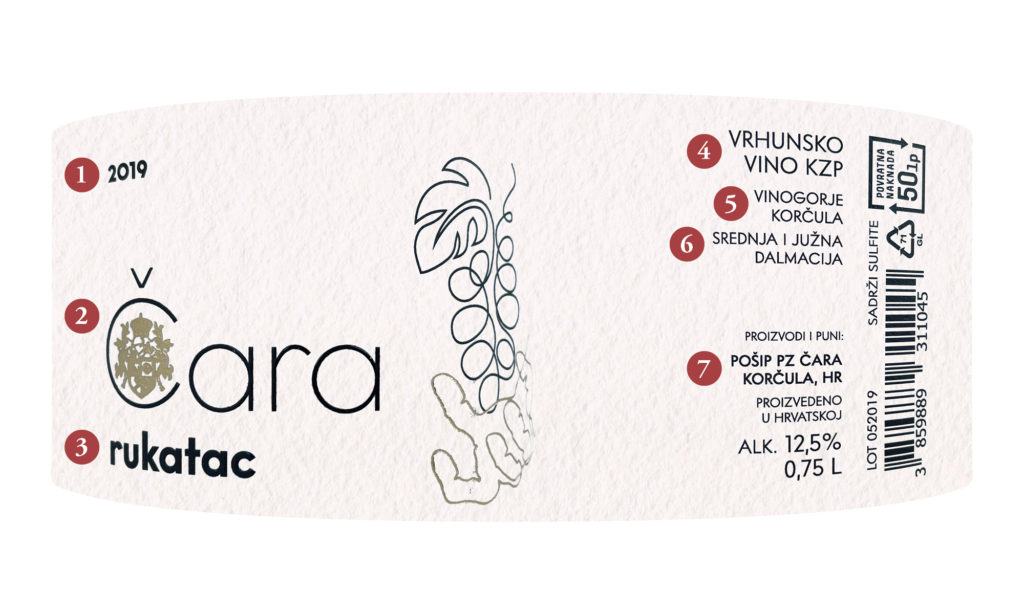
White Wine Label
This label shows the same categories of information as the red wine label—only the specifics differ, so we will cover only those.
1. The vintage, or the year the grapes were harvested. The Croatian word is berba; you may see vintage worded as “Berba 2019” or “Berba 2019. godina” (Harvest 2019th year).
2. Name of the winery. Čara is the name of the winery, which also happens to be the name of the town and valley where the grapes were grown. See #7.
3. Grape variety. Rukatac is the grape variety, another name for the Maraština grape. A truly devilish fact about grape varieties is that each one has different names in different places.
4. Vrhunsko Vino KZP, Premium-quality wine with controlled geographical origin. See #4 and #5 under red wine.
5. Origin of the fruit. In this case, it is Korčula vineyards, which is more specific than #6.
6. The name of the official PDO/ZOI (see #5 for red wine).
7. Proizvodi i puni. This is the name of the winery where the wine was produced and filled (proizvodi i puni). The cool trivia here is that the letters PZ in a winery name stand for Poljoprivredna Zadruga, which means agricultural cooperative. These are the cooperative wineries left from Croatia’s communist years, many of which produce excellent wine.
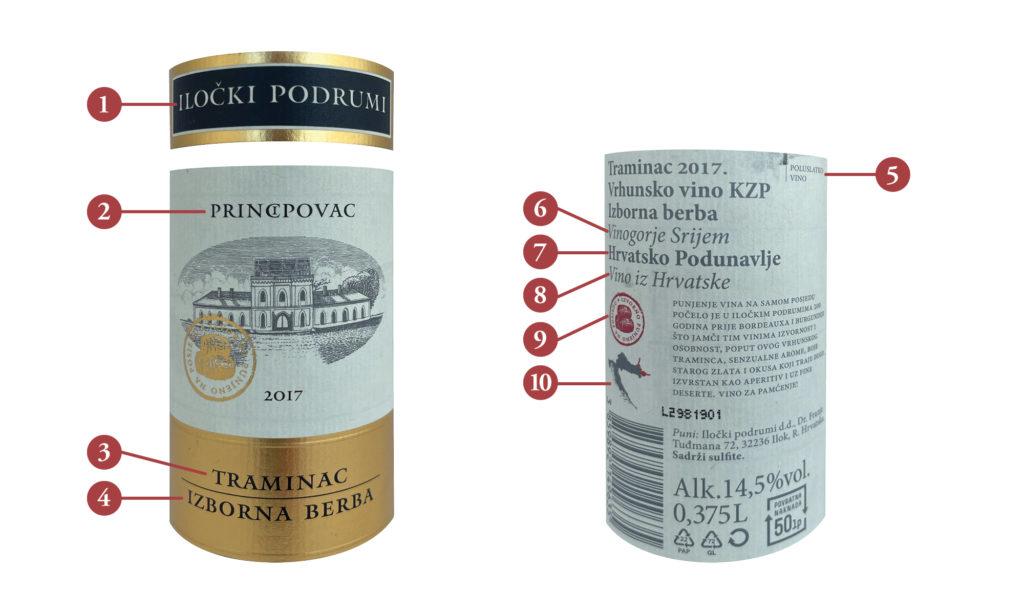
Sweet Wine Label
Again, look to the red wine label for all the basic data; here we will cover details specific to this wine.
1. The name of the winery, which translates to Ilok Cellars.
2. Vineyard. Principovac is the name of the winery’s most famous vineyard site, where the grapes for this wine came from. Since there’s no way to know the name of every vineyard everywhere, you’ll probably need to look up this kind of info on the winery web site.
3. Grape variety. Traminac is a specialty of far eastern Croatia. It is genetically the same as Gewürztraminer.
4. “Izborna berba.” A term generally only used for sweet wine, this means selected harvest, and indicates that only selected bunches or berries were picked, only when they were perfectly overripe. Other, similar terms you may see are kasna berba (late harvest) and izborna berba bobica (selected harvest berries: individual berries were picked from the bunch). These processes mean that pickers must go into the vineyards numerous times to harvest individual bunches or berries as they ripen—one reason sweet wines are more expensive.
5. Poluslatko vino, or half-sweet wine, gives you an idea of the level of sweetness. Half-sweet is less sweet than slatko vino, or fully sweet wine.
6-8. Origin of the grapes. These three lines give you information on the origin of the grapes, from most specific to least specific. Vinogorje Srijem is the location of the vineyards; Hrvatsko Podunavlje is the broader region where the vineyards are (also the official PDO/ZOI); and it is wine from Croatia.
9. Random seal. This falls into the category of marketing, which can be both confusing and helpful on a wine label. In this case, the seal represents an interesting fact explained in the Croatian text on the label: that Iločki Podrumi was bottling its wine on the property 200 years before the French regions of Bordeaux and Burgundy started doing it. Just a little brag—and rightly so.
10. Map of Croatia. Some wineries highlight their region on a silhouette of Croatia. Optional but truly helpful.
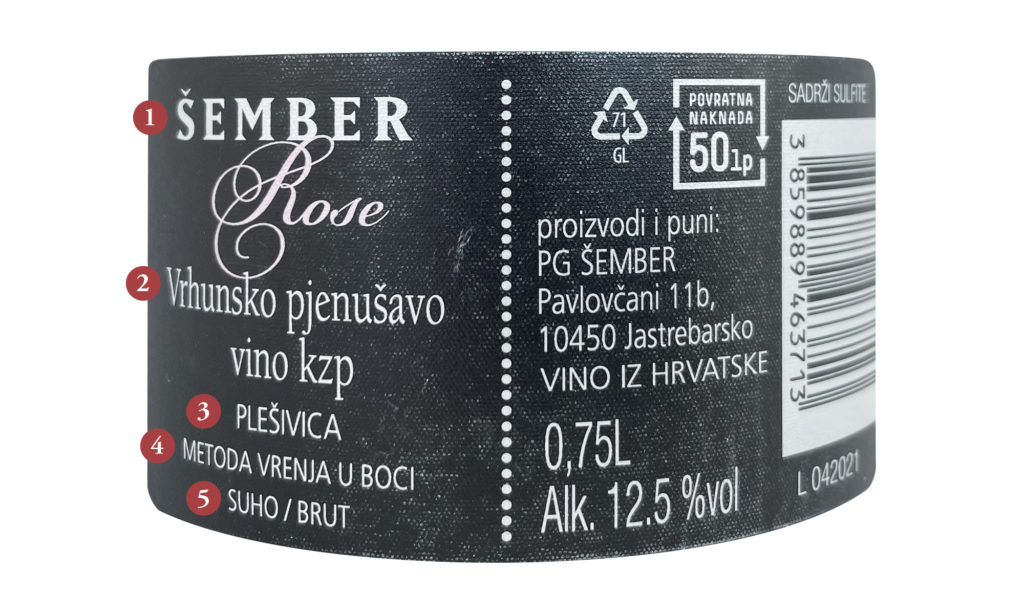
Sparkling Wine Label
Look up at the red label for the basics; here we’ll cover a few terms that apply to sparkling wine only.
1. Winery name, in this case Šember.
2. The official quality rating, combined with the type of wine. Vrhunsko is premium (top) quality, with the addition of pjenušavo, which means sparkling.
3. Where the wine came from. Plešivica is the region just west of Zagreb that is especially known for its sparkling wines. It is also the official PDO/ZOI (see #5 for red wine).
4. “Metoda vrenja u boci.” This translates as “boiling in bottle method,” but don’t worry! It may sound like something you’d never want to do to a wine, but it’s actually a colorful term for the Traditional Method used in Champagne, where the second fermentation that produces the bubbles takes place in the same bottle the wine is sold in. For the best-quality sparkling wine, you want to see these words, or some reference to Tradicionalna Metoda or Klasične Metode.
[All photos: Staff/CCM]
This article was originally published as a guest contribution to Expat in Croatia–all you need to live and travel like a local in Croatia.

